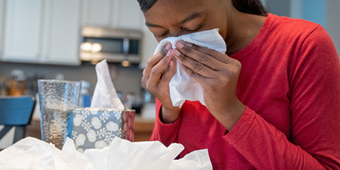Why You Shouldn’t Ignore the Threat of Tuberculosis

Find Your Perfect Match
Answer a few questions and we'll provide you with a list of primary care providers that best fit your needs.
If you think that tuberculosis is a disease of the past, think again. While most cases occur abroad, people in the U.S. still suffer from TB. In fact, TB cases have been reported in all 50 states and the District of Columbia.
So, it pays to be in the know about this rare but serious health threat and its symptoms.
What Causes TB?
Tuberculosis is an infection caused by bacteria. It’s spread through the air from one person to another when an infected person coughs, sneezes or laughs. Even though the bacteria travel easily, it’s not easy to become infected by TB. Most often, it’s spread between family members, close friends and people who live or work together.
Even though the bacteria travel easily, it’s not easy to become infected by TB. Most often, it’s spread between family members, close friends and people who live or work together.
Are You at Risk?
TB infection is rare, but the risk is greater if you:
- Have close contact with someone with infectious TB
- Travel to or come from countries with high rates of TB
- Have a condition that weakens your immune system, like HIV, substance abuse or an illness that is treated with steroids
- Are homeless or inject illegal drugs
- Are elderly
- Work or live with people in places like hospitals, homeless shelters, prisons, nursing homes or residential homes for people with HIV
What Are the Symptoms?

Symptoms depend on where in the body the TB bacteria are growing. Most often, they grow in the lungs (pulmonary TB). But not everyone infected with TB bacteria becomes sick.
There are two TB-related conditions: inactive TB infection and TB disease. With inactive, or latent, TB infection, the bacteria live in your body but don’t make you sick. Most people with TB infection will have no symptoms and will never develop the disease. And they can’t spread the TB bacteria to others.
Someone with active TB disease in the lungs may have these symptoms:
- A bad cough that lasts three weeks or longer
- Chest pain
- Coughing up blood
Other symptoms may include:
- Weakness or fatigue
- Weight loss
- No appetite
- Chills
- Fever
- Night sweats
These symptoms can also be caused by other diseases, so it’s important to see your doctor to rule out TB.
Is TB Preventable?
TB is a preventable and curable disease. Testing for and treating inactive TB in high-risk populations is the most effective way to prevent TB disease. If you have inactive TB infection, it’s unlikely that you will develop TB disease. However, you should still receive preventive treatment.
If you are traveling abroad, keep in mind that in many countries TB is much more common than in the U.S. Air travel itself carries a relatively low risk of infection. More important is avoiding close contact with known TB patients in crowded environments like clinics, hospitals, prisons or homeless shelters.
While there is a vaccine for TB, it’s not widely used in the U.S. It may be recommended for some people, such as health care workers with constant exposure to TB patients.
What About Treatment?
TB can almost always be treated and cured. Inactive and active TB can be treated with medicines.
- If TB is inactive: The most common preventive therapy is a daily dose of the medicine isoniazid (INH) for six to nine months. This treatment kills germs that are not doing any damage now but could in the future.
- If TB is active: You will probably be treated with INH and a combination of other drugs for six to 12 months. Your treatment may require a short hospital stay, followed by taking medication at home. After a few weeks, you’ll likely feel better and can return to normal activities without fear of infecting others.
How Common Is TB in the U.S.?
Tuberculosis is very common worldwide, but not in the U.S. According to the Centers for Disease Control and Prevention, more than 9,000 cases were reported in 2016.
Most TB patients in the U.S. were born in other countries where the disease is more common. That said, TB still exists in the U.S. so it’s important to talk with your doctor if you think you have been exposed.
Find Your Perfect Match
Answer a few questions and we'll provide you with a list of primary care providers that best fit your needs.
Source: Centers for Disease Control and Prevention (CDC); Medline Plus; American Lung Association




